Problem 4.1P: Each of the bodies shown is homogeneous and has a mass of 30 kg. Assume friction at all contact... Problem 4.2P: Each of the bodies shown is homogeneous and has a mass of 30 kg. Assume friction at all contact... Problem 4.3P: Each of the bodies shown is homogeneous and has a mass of 30 kg. Assume friction at all contact... Problem 4.4P: The homogeneous bar weighs 12 lb. It is resting on friction surfaces at A and B. Draw the FBD of the... Problem 4.5P: The homogeneous beam AB weighs 400 lb. For each support condition shown in (a) through (d), draw the... Problem 4.6P: The homogeneous triangular plate has a mass of 12 kg. Draw the FBD of the plate for each set of... Problem 4.7P: The bracket of negligible weight is supported by a pin at A and a frictionless peg at B, which can... Problem 4.8P: The figure models the handle of the water cock described in Prob. 4.9. Draw the FBD of the handle,... Problem 4.9P: The high-pressure water cock is rigidly attached to the support at D. Neglecting the weights of the... Problem 4.10P: Draw the FBD of the entire frame, assuming that friction and the weights of the members are... Problem 4.11P: The figure is a model for member CDE of the frame described in Prob. 4.10. Draw the FBD of the... Problem 4.12P: The homogeneous cylinder of weight Wrests in a frictionless right-angled corner. In the position... Problem 4.13P: Calculate the force P that is required to hold the 120-lb roller at rest on the rough incline. Problem 4.14P: The 60-lb homogeneous disk is suspended from a belt that runs from B to C. The spring OA holds the... Problem 4.15P: The 180-kg uniform boom ABC, supported by a horizontal cable at B and a pin at A, carries a 320-kg... Problem 4.16P: The table lamp consists of two uniform arms, each weighing 0.6 lb, and a 1.8-lb bulb fixture. If... Problem 4.17P: At what angle will the lamp in Prob. 4.16 be in equilibrium without the couple CA? Problem 4.18P: The bent beam ABC is supported by a pin at B and a roller at C. Neglecting the weight of the beam,... Problem 4.19P: Compute all reactions at the base A of the traffic light standard, given that the tension in the... Problem 4.20P: The man is holding up the 35-kg ladder ABC by pushing perpendicular to the ladder. If the maximum... Problem 4.21P: The 1200-lb homogeneous block is placed on rollers and pushed up the 10 incline at constant speed.... Problem 4.22P: The uniform plank ABC weighs 400 N. It is supported by a pin at A and a cable that runs around the... Problem 4.23P: The center of gravity of the 850-N man is at G. If the man pulls on the rope with a 388-N force,... Problem 4.24P: The homogeneous 340-lb sign is suspended from three wires. Find the tension in each wire. Problem 4.25P: When the truck is empty, it weighs 6000 lb and its center of gravity is at G. Determine the total... Problem 4.26P: The homogeneous bar AB weighs 25 lb. Determine the magnitudes of the forces acting on the bar at A... Problem 4.27P: Determine the smallest horizontal force P that would push the homogeneous cylinder of weight W over... Problem 4.28P: The homogeneous beam AB weighing 800 lb carries the distributed load shown. Find the support... Problem 4.29P: The homogeneous 40-kg bar ABC is held in position by a horizontal rope attached to end C. Neglecting... Problem 4.30P: The horizontal force P is applied to the handle of the puller. Determine the resulting tension T in... Problem 4.31P: The homogeneous plate of weight W is suspended from two cables. Determine the force P that is... Problem 4.32P: Neglecting the mass of the beam, compute the reactions at A and B. Problem 4.33P: The 1200-kg car is being lowered slowly onto the dock using the hoist A and winch C. Determine the... Problem 4.34P: The crate weighing 400 lb is supported by three ropes concurrent at B. Find the forces in ropes AB... Problem 4.35P: Find the smallest value of P for which the crate in the Prob. 4.34 will be in equilibrium in the... Problem 4.36P: Determine the rope tension T for which the pulley will be in equilibrium. Problem 4.37P: The 40-kg homogeneous disk is resting on an inclined friction surface. (a) Compute the magnitude of... Problem 4.38P: The 40-kghomogeneous disk is placed on a frictionless inclined surface and held in equilibrium by... Problem 4.39P: The mass of the uniform bar AB is 80 kg. Calculate the couple C required for equilibrium if (a) =0;... Problem 4.40P: The mechanism shown is a modified Geneva drive-a constant velocity input produces a varying velocity... Problem 4.41P: The center of gravity of the 3000-lb car is at G. The car is parked on an incline with the parking... Problem 4.42P: The 30-lb block is held in place on the smooth inclined plane by the force P. (a) Knowing that =20,... Problem 4.43P: The vertical post is supported by two cables (the cable BFC runs over a smooth peg at F) and an... Problem 4.44P: The uniform ladder of weight W is raised slowly by applying a vertical force P to the rope at A.... Problem 4.45P: The uniform, 30-lb ladder is raised slowly by pulling on the rope attached at A. Determine the... Problem 4.46P: The 90-kg man, whose center of gravity is at G, is climbing a uniform ladder. The length of the... Problem 4.47P: The bar ABC is constrained by the pin support A and the cable BD. Determine the force in the cable... Problem 4.48P: The tensioning mechanism of a magnetic tape drive has a mass of 0.4 kg, and its center of gravity is... Problem 4.49P: The homogeneous 300-kg cylinder is pulled over the 100-mm step by the horizontal force P. Find the... Problem 4.50P: Compute the magnitudes of the reactions at pin A and the roller at D. Neglect the weight of the... Problem 4.51P: Each of the sandbags piled on the 380-lb uniform beam weighs 14 lb. Determine the support reactions... Problem 4.52P: The 18-ft pole is supported by a pin at A and a vertical cable at B. Determine the force in the... Problem 4.53P: The supporting structure of the billboard is attached to the ground by a pin at B, and its rear leg... Problem 4.54P: The self-regulating floodgate ABC, pinned at B, is pressed against the lip of the spillway at C by... Problem 4.55P: The cantilever beam is built into a wall at O. Neglecting the weight of the beam, determine the... Problem 4.56P: Determine the force F required to keep the 200-kg crate in equilibrium in the position shown. Problem 4.57P: The uniform rod AB of weight W is supported by the two inclined planes. Neglecting friction,... Problem 4.58P: A machine operator produces the tension Tin the control rod by applying the force P to the foot... Problem 4.59P: The dump truck consists of a chassis and a tray, with centers of gravity at G1 and G2, respectively.... Problem 4.60P: The centers of gravity of the 50-kg lift truck and the 120-kg box are at G1 and G2, respectively.... Problem 4.61P: (a) draw the free-body diagrams for the entire assembly (or structure) and each of its parts.... Problem 4.62P: (a) draw the free-body diagrams for the entire assembly (or structure) and each of its parts.... Problem 4.63P: For Probs. 4.61–4.68, (a) draw the free-body diagrams for the entire assembly (or structure) and... Problem 4.64P: (a) draw the free-body diagrams for the entire assembly (or structure) and each of its parts.... Problem 4.65P: (a) draw the free-body diagrams for the entire assembly (or structure) and each of its parts.... Problem 4.66P: (a) draw the free-body diagrams for the entire assembly (or structure) and each of its parts.... Problem 4.67P: (a) draw the free-body diagrams for the entire assembly (or structure) and each of its parts.... Problem 4.68P: (a) draw the free-body diagrams for the entire assembly (or structure) and each of its parts.... Problem 4.69P: The two uniform cylinders, each of weight W, are resting against inclined surfaces. Neglecting... Problem 4.70P: Draw the FBDs for the following: (a) bar ABC with pin A inside the bar; (b) bar ABC with pin A... Problem 4.71P: Draw the FBDs for the beam ABC and the segments AB and BC. Note that the two segments are joined by... Problem 4.72P: Draw the FBDs for the entire structure and the member BDE. Count the total number of unknowns and... Problem 4.73P: The beam consists of the bars AB and BC connected by a pin B. Determine the support reactions at A.... Problem 4.74P: For the frame shown, determine the magnitude of the pin reaction at B. Neglect the weight of the... Problem 4.75P: Determine the magnitudes of the pin reactions at A and C. Neglect the weights of the members. Problem 4.76P: The bars AB and AC are joined by a pin at A and a horizontal cable. The vertical cable carrying the... Problem 4.77P: Neglecting the weights of the members, determine the magnitude of the pin reaction at D when the... Problem 4.78P: Calculate the magnitudes of the pin reactions at A and C. Neglect the weights of the members. Problem 4.79P: Determine the magnitude of the pin reaction at A as a function of P. The weights of the members are... Problem 4.80P: Neglecting friction and the weights of the members, compute the magnitudes of the pin reactions at A... Problem 4.81P: When activated by the force P, the gripper on a robotic arm is able to pick up objects by applying... Problem 4.82P: Determine the axle loads (normal forces at A, B, and C) for the ore hauler when it is parked on a... Problem 4.83P: Determine the force P that would produce a tensile force of 25 lb in the cable at E. Neglect the... Problem 4.84P: The pulley-cable system supports the 150-lb weight. The weights of the pulleys and the horizontal... Problem 4.85P: Determine the contact force between the smooth 90-kg ball B and the horizontal bar, and the... Problem 4.86P: Compute the tension in the cable and the contact force at the smooth surface B when the 300-Nm... Problem 4.87P: Determine the magnitude of the pin reaction at B. Neglect the weights of the members. Problem 4.88P: Determine the tension in the cable at B, given that the uniform cylinder weighs 350 lb. Neglect... Problem 4.89P: Compute the magnitude of the pin reaction at B. Neglect the weights of the structural members. Problem 4.90P: Neglecting the weight of the frame, find the tension in cable CD. Problem 4.91P: Determine the clamping force at A due to the 15-lb horizontal force applied to the handle at E. Problem 4.92P: Compute the tension in the cable BD when the 165-lb man stands 5 ft off the ground, as shown. The... Problem 4.93P: Calculate the reactions at the built-in support at C, neglecting the weights of the members. Problem 4.94P: Determine the magnitudes of the roller reactions at C and D. Neglect the weights of the members. Problem 4.95P: The linkage of the braking system consists of the pedal arm DAB, the connecting rod BC, and the... Problem 4.96P: The window washers A and B support themselves and the 40-lb uniform plank CD by pulling down on the... Problem 4.97P: The figure shows a wire cutter. Determine the cutting force on the wire at A when the 75-N forces... Problem 4.98P: Find the tension T in the cable when the 180-N force is applied to the pedal at E. Neglect friction... Problem 4.99P: The 400-kg drum is held by tongs of negligible mass. Determine the magnitude of the contact force... Problem 4.100P: Compute the magnitudes of all forces acting on member CDE of the frame. Problem 4.101P: Calculate all forces acting on member CDB. Problem 4.102P: The automatic drilling robot must sustain a thrust of 32 lb at the tip of the drill bit. Determine... Problem 4.103P: Determine the clamping (vertical) force applied by the tongs at E. Problem 4.104P: Determine the axial force in member BC of the frame. Note the joint D is a sliding pin. Problem 4.105P: Neglecting friction, determine the relationship between P and Q, assuming that the mechanism is in... Problem 4.106P: Find the magnitudes of the pin reactions at A and C. Problem 4.107P: The load in the bucket of a skid steer loader is 600 lb with its center of gravity at G. For the... Problem 4.108P: Determine the magnitude of the roller reaction at E. Problem 4.109P: The tool shown is used to crimp terminals onto electric wires. The wire and terminal are inserted... Problem 4.110P: The 12-lb force is applied to the handle of the toggle cutter. Determine the force exerted by the... Problem 4.111P: The blade of the bulldozer is rigidly attached to a linkage consisting of the arm AB, which is... Problem 4.112P: Find the magnitudes of the pin reactions at A, C, and E caused by the 260-Nm couple. Problem 4.113P: The pins at the end of the retaining-ring spreader fit into holes in a retaining ring. When the... Problem 4.114P: Determine the magnitudes of the support reactions at A, D, and E. Problem 4.115P: Find the magnitude of the pin reaction at C. Assume that the 180-lb force is applied to the pin at... Problem 4.116P: For the pliers shown, determine the relationship between the magnitudes of the applied forces P and... Problem 4.117P: The device shown is an overload prevention mechanism. When the force acting on the smooth peg at D... Problem 4.118P: The figure is a schematic of a wire cutter. Determine the force applied by the cutting blade to the... Problem 4.119P: The hinge shown is the type used on the doors of some automobiles. If a torsion spring at F applies... Problem 4.120P: Determine the force in the hydraulic cylinder EF that would maintain the parallelogram mechanism in... Problem 4.121P: Determine the horizontal force P that would keep the uniform 12-kg rectangular plate in the position... Problem 4.122P: Determine the magnitudes of the forces acting on the bracket at B and C. Problem 4.123P: Determine the angle at which the bar AB is in equilibrium. Neglect friction. Problem 4.124P: The automobile, with center of gravity at G, is parked on an 18 slope with its brakes off. Determine... Problem 4.125P: The figure shows a three-pin arch. Determine the horizontal component of the pin reaction at A... Problem 4.126P: The center of gravity of the nonhomogeneous bar AB is located at G. Find the angle at which the bar... Problem 4.127P: When suspended from two cables, the rocket assumes the equilibrium position shown. Determine the... Problem 4.128P: The pump oiler is operated by pressing on the handle at D, causing the plunger to raise and force... Problem 4.129P: The uniform 240-lb bar AB is held in the position shown by the cable AC. Compute the tension in the... Problem 4.130P: Find the force P required to (a) push; and (b) pull the 80-lb homogeneous roller over the 3-in.... Problem 4.131P: Using the method of joints, calculate the force in each member of the trusses shown. State whether... Problem 4.132P: Using the method of joints, calculate the force in each member of the trusses shown. State whether... Problem 4.133P: Using the method of joints, calculate the force in each member of the trusses shown. State whether... Problem 4.134P: Using the method of joints, calculate the force in each member of the trusses shown. State whether... Problem 4.135P: Using the method of joints, calculate the force in each member of the trusses shown. State whether... Problem 4.136P: Using the method of joints, calculate the force in each member of the trusses shown. State whether... Problem 4.137P: Using the method of joints, calculate the force in each member of the trusses shown. State whether... Problem 4.138P: Using the method of joints, calculate the force in each member of the trusses shown. State whether... Problem 4.139P: Using the method of joints, calculate the force in each member of the trusses shown. State whether... Problem 4.140P: Using the method of joints, calculate the force in each member of the trusses shown. State whether... Problem 4.141P: Identify all the zero-force members in the four trusses shown. Problem 4.142P: The walkway ABC of the footbridge is stiffened by adding the cable ADC and the short post of length... Problem 4.143P: Find the force in member EF. Problem 4.144P: Determine the forces in members AE, BE, and ED. Problem 4.145P: Determine the reaction at E and the force in each member of the right half of the truss. Problem 4.146P: Determine the force in member AD of the truss. Problem 4.147P: Determine the force in member BE of the truss. Problem 4.148P: Show that all diagonal members of the truss carry the same force, and find the magnitude of this... Problem 4.149P: Determine the forces in members FG and AB in terms of P. Problem 4.150P: Determine the forces in members BC, BG, and FG. Problem 4.151P: Determine the forces in members EF, BF, and BC. Problem 4.152P: Compute the forces in members EF, NE and NO. Problem 4.153P: Repeat Prob. 4.152 assuming that the 400-kN force is applied at O instead of L. Problem 4.154P: Determine the forces in members BG, CI, and CD. Problem 4.155P: Assuming that P=48000lb and that it may be applied at any joint on the line FJ, determine the... Problem 4.156P: Calculate the forces in members BC, CF, and FG. Problem 4.157P: Find the forces in members CD, DH, and HI. Problem 4.158P: Determine the forces in members CD and DF. Problem 4.159P: Compute the forces in members CD and JK, given that P=300lb and Q=1000lb. (Hint: Use the section... Problem 4.160P: If PCD=6000lb and PGD=1000lb (both compression), find P and Q. Problem 4.161P: Determine the forces in members EF, BF, and BC. Problem 4.162P: Determine the forces in members AC, AD, and DE. Problem 4.163P: Determine the forces in members GI, PH, and GH. Figure P4.162, P4.163 Problem 4.164P: Determine the forces in members CD, IJ, and NJ of the K-truss in terms of P. Problem 4.165P: Calculate the forces in members AB and DE. Problem 4.166P: (a) Find the forces in members CE, CF, and DF. (b) Identify all the zero -force members. Problem 4.167P: Determine the forces in members BC and BE and the horizontal pin reaction at G. Problem 4.168P: A couple acting on the winch at G slowly raises the load W by means of a rope that runs around the... Problem 4.169RP: The uniform, 20-kg bar is placed between two vertical surfaces. Assuming sufficient friction at A to... Problem 4.170RP: The 320-lb homogeneous spool is placed on the inclined surface. Determine the vertical force P that... Problem 4.171RP: Determine the magnitude of the pin reaction at A, assuming the weight of bar ABC to be negligible. Problem 4.172RP: Determine the couple C that will hold the bar AB in equilibrium in the position shown. Neglect the... Problem 4.173RP: The 800-lb force is applied to the pin at E. Determine the magnitude of the force exerted by pin E... Problem 4.174RP: The weight W=6kN hangs from the cable which passes over the pulley at F. Neglecting the weights of... Problem 4.175RP: The 2000-lb and 6000-lb forces are applied to the pins at B and C, respectively. Calculate the... Problem 4.176RP: The two couples act at the midpoints of bars AB and BD. Determine the magnitudes of the pin... Problem 4.177RP: Determine the forces in members AC and AD of the truss. Problem 4.178RP: Determine the angle for which the uniform bar of length L and weight W will be in equilibrium.... Problem 4.179RP: Determine the magnitude of the force exerted by the pin at E on member ACE. Assume that the forces... Problem 4.180RP: Calculate the forces in members (a) DE; (b) BE; and (c)BC. Indicate tension or compression. Problem 4.181RP: Determine the ratio P/Q for which the parallel linkage will be in equilibrium in the position shown.... Problem 4.182RP: The 30-lb block C rests on the uniform 14-lb bar AB. The cable connecting C to B passes over a... Problem 4.183RP: The 30-lb homogeneous bar AB supports the 60-lb block. The ends of the bar rest on frictionless... Problem 4.184RP: Determine the forces in members (a) EF; and (b) BC. Indicate tension or compression. Problem 4.185RP: Find the magnitude of the pin reaction at B caused by the weight W=80lb. Neglect the weights of the... Problem 4.186RP: The breaking strength of the cable FG that supports the portable camping stool is 400 lb. Determine... Problem 4.187RP: Determine the forces in members GH, BH, and BC of the truss. Problem 4.188RP: The 80-N force is applied to the handle of the embosser at E. Determine the resulting normal force... Problem 4.189RP: The tongs shown are designed for lifting blocks of ice. If the weight of the ice block is W, find... format_list_bulleted
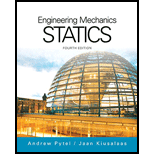
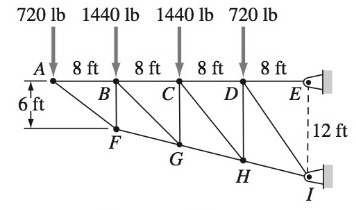


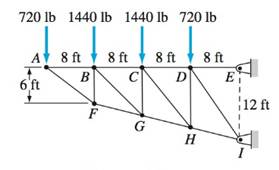
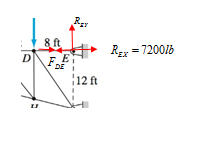
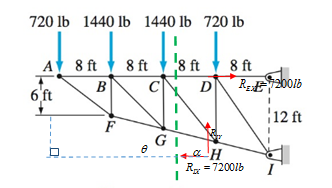
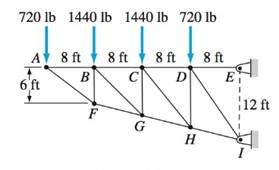

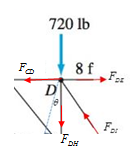
 International Edition---engineering Mechanics: St...Mechanical EngineeringISBN:9781305501607Author:Andrew Pytel And Jaan KiusalaasPublisher:CENGAGE L
International Edition---engineering Mechanics: St...Mechanical EngineeringISBN:9781305501607Author:Andrew Pytel And Jaan KiusalaasPublisher:CENGAGE L